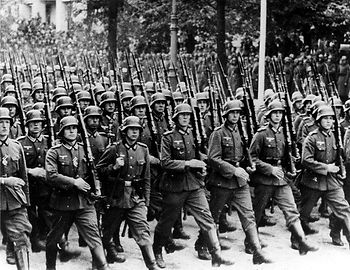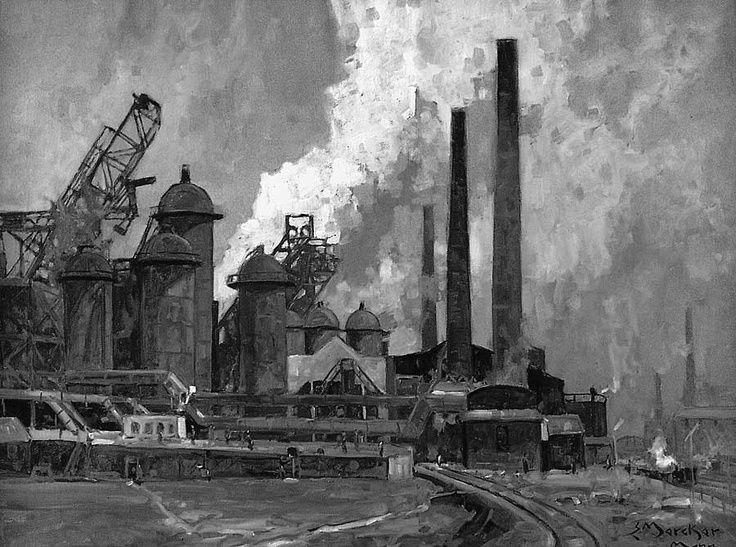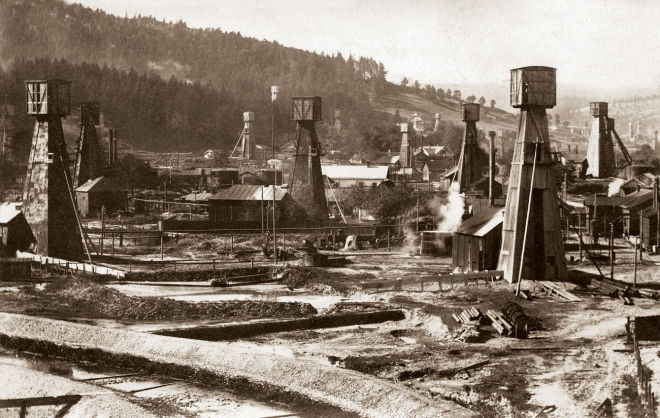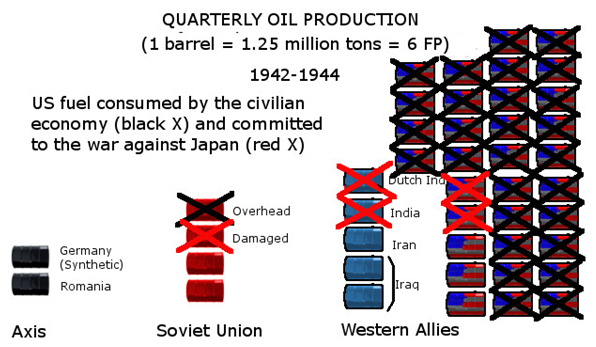Reaching for Resource Points
By Frank Chadwick
The ETO Production system is based on the expenditure of Resource Points (RPs). Although they are spent down turn-by-turn (up to a limit of 10% of that RP's reserve or 2, whichever is greater), they are produced (and added to their RP pool) Seasonally.
There are three types of RPs in ETO, as listed here:
Manpower: Personnel points (PPs) produced by urban population centers
Equipment: Equipment points (EPs) produced by industrial centers
Fuel: Fuel points (FPs) produced at Oil resource areas.
These are described in greater detail below:
Manpower (PPs)

Every year, a nation generates new military service manpower equal to about 2% of its total population. It cannot continue to generate that sort of surplus forever (in part, because it is always losing some manpower through natural attrition), but in wartime combat attrition dwarfs natural attrition. In addition, the game does not go on forever, so we don’t have to make a model that works beyond the timespan of the game.
Each population center (a uniformed person icon on the map) represents an aggregate national population of 10 million.
Each 10 million population produces up to 200,000 men of military age per year.
Each PP represents 25,000 inductees.
Therefore, each population center in the game generates 2 PPs per Season while at war; peacetime/hindered/scathed production is half that (see its rules below).
Each Medium (Corps) size Infantry type unit typically costs 2 PPs to build from scratch to full strength, or 1 PP to build at reduced strength or to replace from reduced strength to full strength.
Some economies are not quite as robust (see the Personnel Problems rule below):
[544.1.1] Personnel Problems:
Various problems can hinder PP production:
Enemies: A conquered Personnel city produces nothing for its captor.
Hindered: Various problems (i.e., low population or insufficient labor mechanization) hinder a nation’s PP production for its armed forces.
When Working, the Personnel cities of these nations produce only 1 PP each Season (instead of 2 which non-hindered nations produce) and, when Scathed, 1/2 PP: Bulgaria, Croatia, Holland, Iran, Italy*, and Yugoslavia. *This is because Italy had a very poorly mechanized (i.e., labor-intensive) economy plus it has large numbers of personnel tied down in paramilitary units (i.e., the Fascist Militia and the Frontier Guards) and these produced very little combat power.
For nations not having a Personnel city hex, their Capital City hex produces its Seasonal PPs as follows: > 1 PP per Season and, when Scathed, 1/2 PP: Denmark, Finland, Iraq, Sweden, and Switzerland. > 1/2 PP per Season whether Scathed or not: Estonia, Latvia, Lithuania, Norway, and Slovakia.
Other Detriments: Besides being Hindered (above), if a Personnel city is Distracted (i.e., part of its contribution is going elsewhere not in that game) or Scathed (i.e., it has been recaptured after serving as a functioning Supply city for the enemy), or recaptured by its owner too late (541.1), it contributes only half of its Working production.
Equipment (EPs)

There are a lot of ways of measuring industrial output. We chose production of steel because most military production is very steel-dependent.
Each industrial production center (factory symbol on the map) represents an annual output of 2 million tons of steel.
Approximately half of all steel produced by all the nations in the war went to civilian/infrastructure needs (many of those constitute infrastructure investments necessary for successful military operations and production, like construction and maintenance of railroads, civilian cargo vehicles, riverine transportation of resources, coastal shipping, machine tools for factories making armaments, etc.).
The remaining output of each production center amounts to 250,000 tons of steel per Season for military use.
Each EP represents 250,000 tons of steel.
Therefore, each industrial center in the game generates 1 EP per Season while at war; peacetime or other disruptions and distractions generate only half that.
Each Medium (Corps) size Heavy type unit typically costs 2 EPs (and 1 FP!) to build from scratch to full strength, or 1 EP (and 1 FP) to build at reduced strength, or just 1 EP to replace from reduced strength to full strength.
[544.1.2] Factory Problems:
Various problems can hinder EP production.
Out of Commission: When a Factory city is Captured (i.e., newly conquered that Season), Retooling (i.e., in the process of coming back on line for its captor), or Relocating (i.e., for evacuated USSR Factory markers making their way to Siberia) it contributes nothing.
Other Detriments: When a Factory city is Integrated (i.e., has been brought back on line for its captor), Relocated (i.e., for USSR Factory markers reestablished in Siberia per 544.2.2), Distracted (i.e., part of its contribution is going elsewhere not in that game), Scathed (i.e., it has been recaptured after serving as a functioning Supply city for the enemy), or Pro-Faction (i.e., its nation is neutral but leaning toward a particular Faction; see 553.5) it contributes only half of its Working production.
Fuel (FPs)

Although there are many components of essential fuels in a national economy, the military economy runs on oil: bunker oil for Naval units, gasoline for Motorized units, and aviation fuel for Air units. The aviation industry is less reliant on steel and more reliant on lighter metals, and so we decoupled aircraft production (in the form of aircraft replacements represented by raising an Air unit from the DESTROYED box to the FLOWN box) from steel (EPs) and tied it to fuel (FPs) since an abundance of fuel is generally associated with a robust aircraft industry. This works very nicely in ETO and kept us from requiring a separate "light industry" resource/production value to fiddle with.
Each Oil resource area (oil well symbol on the map) represents an annual output of 5 million tons of oil, which is 1,250,000 tons per Season.
Each FP represents 200,000 tons of oil (or its refined equivalent).
Therefore, each Oil resource area produces 6 FPs per season. Once captured, this is permanently reduced by half to only 3 FPs per season for its owner.Fuel Points serve a myriad of functions keeping the mechanized elements of the armed forces (i.e., tanks, planes, and ships) going.
[544.1.3] Oil Problems:
Various problems can hinder FP production.
Out of Commission: When an Oil city is Burning (i.e., newly conquered that Season) or Repairing (i.e., in the process of coming back on line for its captor) it contributes nothing. This is an ETO rule new to TITE players.
Other Detriments: When an Oil city is Recovered (i.e., brought on line for its captor; this is a permanent condition and cannot be repaired in the scope of this game), Distracted (i.e., part of its contribution is going elsewhere not in that game), or Pro-Faction (i.e., its nation is neutral but leaning toward a particular Faction; see 553.5) it contributes only half of its Working production.
About the world’s oil:
At the height of the war (1942-44), oil resource areas looked like this:

Axis = 2: 1 from Germany (producing synthetics from their coal gasification program) + 1 from Romania
Soviet = 3.5: 2 from the Caucasus + 1 Damaged from Maikop in the Caucasus (at half production after Axis take it in 1942; + 1 in Kuybyshev which is consumed each quarter by the civilian/infrastructure economy Most of the Soviet Union's oil comes from a number of wells around the city of Baku, which is just off the east edge of the map in the Caucasus region. To avoid the need for a map extension or a messy rules addition, we shifted its production to Maikop, Grozny, and Tbilisi, none of which would have qualified as an oil producing hex on their own, but together show the value of the Caucasus region to the Soviet military economy.
Western Allied = 38 (yes, 38!!): 2 from Iraq + 1 from Iran + 3 from the USA (and that is it for ETO!); 1 from the Dutch East Indies + 1 from India + 2 from the USA all spent fighting the Japanese; 28 from the USA are consumed each quarter by the American civilian economy!
The Build Cost Chart

What You Learn by Observing the Soviet Economy in Thunder in the East
The Soviet production system is a nice window showing how production will work for all of the Nations in the ETO campaign game. In Thunder in the East we simplify the Axis economy by giving them a fixed number of various Resource Points (RPs) each Season (those not spent on the other fronts). With the Soviet economy, however, you get to see the entire system that actually generates their RPs and what they represent.
As mentioned elsewhere in this guide, we deliberately divided production between three key resources: population, heavy industry, and fuel. The different quantities of resources available dictated the types of armies raised and created asymmetrical forces.
Lots of population means lots of infantry.
Lots of heavy industry means plenty of armor, naval units, and ammunition (a.k.a. Offensive Points – OPs – provided there is fuel to go with it).
Lots of fuel means a more numerous and active Air Force, more potential for motorization, and possibly better logistical support (more Headquarter markers and OPs).
Replacements: Economics Made Easy

One goal we set out to achieve was incorporating strategic production into a fairly conventional wargame replacement system (sticking with our Battle for Moscow roots). We wanted there to be a variety of resources but didn't want to have to grapple with producing steel and pumping oil every turn, so we made economic management a Seasonal endeavor. The question became how to keep a player from dumping the entirety of a Season’s production into play on the first turn of that Season without creating a burdensome system for spreading it out throughout those turns. We adopted the “10% method,” with a minimum and maximum value allowed every turn, and that has proven to work pretty well.
Ultimately, the only long-duration manufacturing to deal with in ETO are naval vessels, which take a year or more to build. The replacement system is also the new unit production system. We don’t care how units got into the Force Pool (e.g., as reinforcements or casualties); what matter is how many RPs you have available this turn to get them out of the Force Pool and into play.
Putting Disband Back Together
Another critical economic factor in the game is the ability to Disband units to recover their manpower and, in some cases, their equipment (but never their fuel). Disbanding at least some of those pre-war Soviet air units, which the initial Luftwaffe Airfields Attack Missions doubtless moved to the Soviet Destroyed box, is a good way to put a few more Rifle Armies in the field. Reorganizing the Early Soviet Mechanized Corps is even better (as this article explains and illustrates) -- not only in providing 2-step Soviet Rifle Armies, but if in communication some EPs to help build up your Shock Armies in the Autumn.
One reason the Soviets achieved such a big chunk of starting EPs is that they scrapped a number of Soviet Battleships and Battlecruisers under construction since the start of the war in Europe. (In ETO, if the Germans put off invading Russia long enough, those ships will actually appear on the map as finished naval units.)
The Contributions of Lend-Lease
Finally, let me add a word about Lend-Lease. The flow of equipment through Allied Lend-Lease to the Soviet Union during the war amounted to about 16 million ton of goods of all types, including over 400,000 motor vehicles and over 17,000 war planes. The most visible effect of Lend-Lease deliveries was that it enabled the widespread motorization of the Red Army. A subsidiary benefit was the availability of a number of useful aircraft designs not otherwise available to the Soviets (and at a time when they most needed them). The eventual sustained Allied delivery rate of 4 Lend-Lease Points (LLPs) per Season to the Soviet Union represents the equivalent of roughly one third of Germany's domestic Seasonal EP output.


In 2018, I discovered the remarkable game Unconditional Surrender! Europe in WW 2. One of the many things that impressed me was how much time and energy could be saved by abstracting an unusual number of things. As I was getting into TITE after five months of immersion in USE, I read Frank's interesting article on his design philosophy. His point about keeping the mechanics and rules exceptions to a minimum so as to allow us to concentrate on more interesting issues seemed consistent with USE, but when I read about his intention to have concrete quantities to tell a better story, I thought that was a step away from the magical abstraction of USE, remembering the excesses of WiF…
Italy seems quite underwhelming with 1 EP and 4 PP per season. (Ontop of their units being in general subpar / minor power strong).
Pratically it means Italian production by itself is pratically 2 times (or 3 if we include the EP) of Romania or Hungary and their troops quality is virtually the same.
Given - as stated in other places - the mechanics are excellent (so most of my post seem criticizing but it's to try to alter what I see a wrong!). The splitting in manpower, heavy industry and fuel is good!